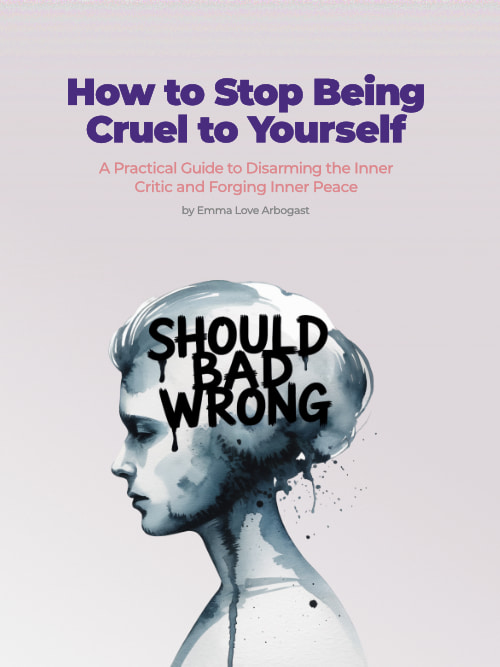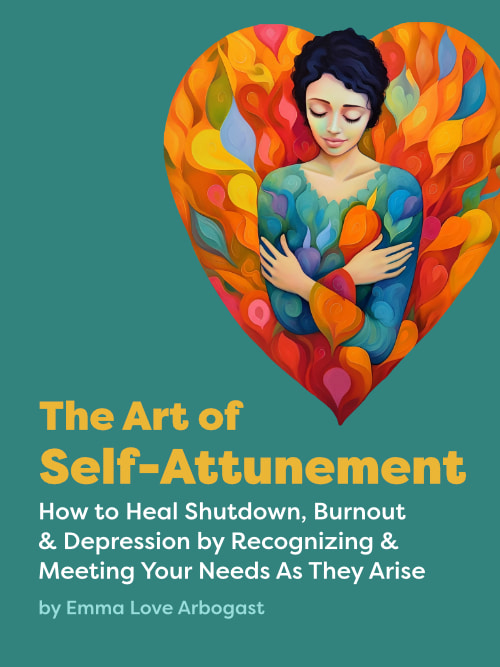How to Process Trauma By Yourself (Without Therapy)
I have worked with my own trauma and attachment trauma over the last 15 years or so, using various methods. While I’m sure therapy is effective for many people, my actual lived experience is that healing trauma isn’t nearly as complicated as it often sounds, and it doesn’t actually require therapy.
First I’m going to talk about why it matters to have “solo” treatment options, what trauma is, and then how to process trauma on your own.
But if you don’t want to read all that, here is the summary:
This method requires you to fully experience overwhelmingly painful feelings. We have an instinctive aversion to pain, so it takes a lot of determination to go straight toward it. But my best results have been when I get triggered by something, and I just lay there and feel the searing pain of it for as long as it takes to dissipate. During it, just witness your thoughts, don’t follow them (more on that below), just feel the sensations themselves. It’s awful, but it does end. You have to condition yourself to do this. Or rather, counter your conditioning to avoid pain by doing something to numb or avoid it, which is very strong, especially if you’ve been trying to avoid this exact pain your whole life through coping mechanisms.
I’ve never found something that is more directly effective at removing trauma from my nervous system.
I recommend you do an honest self-assessment on whether you can handle this technique before trying it. If you are not stable generally, I definitely recommend you work on stabilization first.
The problem with the therapy model of treating trauma
I’m not a therapist, but I’ve studied various therapy modalities and taken trainings specifically focused on trauma. Since these trainings were for therapists, they were understandably biased in favor of therapy as pretty much the way of treating it.
There are several big problems with this.
First, therapy is expensive. A huge number of people can neither afford, nor do they really have the time to do therapy, if they work full time and have kids. For most people, it’s a luxury that’s just not realistic. The individual therapy model just isn’t designed to help the most people with the most trauma.
Second, therapy is offered by people who are overwhelmingly white and middle-class. Therapy training has historically emphasizes the individual psychology of the person, and systemic oppression was pretty much ignored as a cause of psychological distress or trauma. Hopefully this is changing, but there are a huge number of therapists out there that were educated without any kind of anti-racism or anti-colonialist lens. That means they can’t help with that kind of trauma, and they are potentially reproducing it.
Therapy needs to be a very safe space. There is an inherent power differential in therapy, so unintentional micro-aggressions or blind spots have the potential to be much more damaging than they even are normally.
Lastly, some of us, due to attachment issues or just personal preference, don’t feel safe or comfortable with the intimacy of therapy. Sitting there face to face staring at a therapist is stressful by itself.
I spent years in therapy not really getting to root issues, because I just didn’t feel safe with another human being there in the room. And I didn’t even realize it. I’m sure it helped on some level, but I wish I had realized that therapy isn’t the gold standard for everyone and there are many other ways to heal.
How to heal your own trauma
What is trauma?
This is a short review — if you want to understand trauma in more detail, you can Google it, or read the book The Body Keeps the Score or anything by Peter Levine.
When you go through a threatening experience, your body has a flight/flight/freeze response, and produces a whole bunch of neuro-chemical reactions (emotions) to help you mobilize to fight or escape the threat. If your body wasn’t able to fully process or discharge all those chemicals at the time, your mind stores that memory with all the original, unprocessed emotions attached to it. You may not have conscious access to the memory, or the emotions, or both, but it’s there somewhere in your subconscious. If you were a baby, it is going to be stored more as an emotional-body memory, because a very young brain doesn’t process events the same way (which is why we can’t remember them).
This memory is your traumatic experience, frozen in time.
Triggers are the dramatic re-experiencing of trauma moments. But that trauma actually affects us all the time. Our brain never forgets, and it is in a constant low-level state of activation, literally all the time, and more so when we are in environments that remind us of the original scenario. This is why unprocessed trauma leads to all kinds of chronic symptoms, like irritability and anxiety and depression.
But I’m going to focus on triggers, because they are the key to undoing it.
What are triggers?
When we come across something in our environment that our brain interprets as similar to the original threat (and that pattern matching can be very loose), you get triggered, and your body floods you with all those original feelings and sensations. It’s basically saying, Oh god, that threat again! It almost killed us last time! Freak out, freak out! Fight, run away, right now!
In that moment of being triggered, time collapses. Your body is still in that original event. It goes into fight/flight/freeze. So you get angry, you want to leave, you shut down.
These are very painful feelings. We also have an instinctive aversion to pain. So we tend to try to immediately re-suppress those feelings, and stuff them back into the subconscious where they were before you got triggered. So, while one part of your brain is freaking out and getting angry or scared or going numb, another part of your brain is going, Oh no, stop being triggered, stop being triggered, stop being triggered! Calm down! Go do anything you have to, to get this awful feeling to stop!
So, we usually will take a deep breathe and count to 10, or eat a pint of ice cream, or do whatever we have to do to get ourselves together.
Unfortunately, calming yourself down just leaves the trigger where it is.
It makes sense, right? If you stuff it back down, it’s just going to be there until you run across something that triggers it again.
And this is the key to the whole thing. If you want to discharge trauma, you have to actually FEEL those horribly painful feelings. All of them. All the way through. Doing nothing to stop them, change them, shorten them, avoid them, or suppress them. That is the actual “processing” that needs to happen.
This means going completely against everything in your brain screaming at you to get away from the pain.
It also goes completely against all our social conditioning to calm down, get it together, etc.
It also goes against most of what I was taught in trauma therapy school, which said that you should get in a really resourced state (feeling good, positive, grounded) and then “dip your toe in the water” of your overwhelming feelings, and work on them slowly. It emphasized putting the memory back together (which is often stored in fragments), and constructing a cohesive story of what happened. And, I’m not going to say that doesn’t work. I’m just saying, my way is a lot faster and seems to work just fine.
Mindfulness is key (and it’s easier than it sounds).
Mindfulness is the act of being aware of your experience at the same time you are having it. It is also called meta-cognitive awareness.
It’s the difference between being engrossed in the story, and being aware that you are a person reading a story. It means holding two different perspectives simultaneously.
It’s simpler than it sounds. Just right now, notice that you are a person, sitting in a room, or wherever you are, reading this sentence. Something happens, right? The moment before, you were just reading the article. Now you are aware that you are reading an article, but you’re still reading. That’s all mindfulness is.
It’s the difference between being swept along in a river, and being on a bridge over the river, watching the river go by.
When you process your trauma, you want to be the person on the bridge, while not stopping the flow of the river whatsoever. You want to let all the thoughts, feelings, sensations, and whatever else your brain or body wants to do happen, while maintaining the awareness that you are a person who is consciously having this experience.
And it’s actually not that hard to do, because you are going to have to be pretty consciously aware to keep yourself from doing whatever you normally do to avoid feeling all of the feelings.
Because when you really go straight toward the feelings, they feel like they are going to kill you.
It can genuinely feel like you are going to die (but you won’t).
I am not going to sugar-coat it. This is going to suck. You know when you feel so sick you kinda wish you were dead? It’s that level of unpleasant.
This is your brain’s survival system. We used to be prey animals running around on the savannah trying not to get eaten. Your mind and body will do everything it can to convince you that you are going to die if you don’t do something other than lay there curled up in a ball crying or shaking.
But you just have to stay there until it’s over. Stay present in the searing pain until it dissipates.
It’s also likely going to generate a whole shit-ton of thoughts ranging from how bad you are to how bad everyone else is to how wrong this, that or the other thing was. Thought are especially vital to let flow beneath the bridge. Once you get caught up in a thought, it will generate more feelings, and you can get stuck in a loop. So you have to just watch and let go of any thoughts and any meaning your mind wants to give to whatever situation triggered you.
If I get too caught up into the story, I try to refocus on a thought like, I’m choosing to feel this now so I won’t have to feel it again. And It will end, I just have to let the process happen.
Remember, the feelings you actually need to discharge are the ones stuck in time, the ones that are overwhelming. You can sort out how you feel about whatever present-day thing triggered you later, because most of your feelings are not actually about anything in the present, even if your thoughts make it sound like they are.
If this sounds like a really shitty way to spend an afternoon, it is. But, it doesn’t usually take that long, anywhere from 5-30 minutes, for the feelings to dissipate. And then that trauma will no longer be hanging out in your nervous system.
Some disclaimers.
I’ve been working with my mind for a long time, and I only really started doing this in the last five years or so. I’m not sure how much preparation someone needs to do this effectively. So, I want to give some warnings.
Mindfulness does take some practice, and it really is key to this process.
If you find that you can’t stay mindful during the process — that you just start spinning in your thoughts and then the feelings don’t dissipate — then it’s not going to work to keep doing it. Thoughts generate their own feelings, and those are not the feelings you need to feel.
Mindfulness is the like a key that unlocks neuroplasticity in the brain. That’s a fancy way of saying, mindfulness is what makes the difference between reliving the event, and processing the event. If you are not using mindfulness when you are processing, you run the risk of just wiring that response in deeper.
One way you can practice is to not start with full-on triggers, but rather with memories of some previous time you were triggered. I don’t think this is as effective to discharge the trauma, but it can be an effective way of training yourself to remain mindful when your mind starts to spin.
This is not for everyone: if the thought of it terrifies and overwhelms you, it may not be for you right now.
This is for people who genuinely think they can handle it. They are going into it knowing it will hurt, but that hurt will be temporary.
If you are afraid of becoming lost in your feelings or going insane, then please, please seek help that works for you. That’s not something I personally relate too–I spent many years lost in the (relative) insanity of depression and have always had a lot of emotional dysregulation, and over time, I developed a trust that my brain will stabilize eventually, usually after a really good nap.
I also would not recommend this for people who have DID, bipolar, or other diagnoses where their dysregulation can be life threatening.
This is just general life advice, but not everyone is the same. I fully believe in owning your own healing process. But at the end of the day, I’m just a lady on the internet, and I can’t possibly know what you are dealing with or what is best for you.
I do encourage you to at least experiment with going toward the pain instead of away from it, and working to develop a very strong mindfulness practice.
As with anything, your mileage may vary.
If you feel like what I wrote here would be too dysregulating, I recommend the Crappy Childhood Fairy’s Daily Practice as a way to develop more emotional stability and brain regulation in a gentle way.
Self-love is a set of skills you can learn

Stop Being Cruel to Yourself
$2.99


Hey there! If you're new here, welcome to the Emmaverse! 🌈✨
About me: I'm autistic/ADHD and I write about how to be free and happy from the inside out.
Keep in touch?
Self-Liberation Society


Yes, you are correct….therapy is expensive and most therapists these days don’t take insurance, so even more expensive.
I have been and still am a therapist although retired, I have always enjoyed and loved my career so prefer to stay active in the field. But, I am going through my own depression and tauma at this time. No, it’s not crippling. It’s annoying because I don’t feel like my usual calm, casual self.
I am interested in treating myself.
Thank you for sharing these insights. I have been following this practice for years. Intuition has lead me on a journey of discovery that your thoughts summed up nicely. Feel the pain. Let it flow through and out. It hurts like HELL but then there is space to heal.
Amazing take, we need to learn how to process things on our own!
This is basically what Acceptance and Commitment Therapy is about. I recommend the book The Happiness Trap to learn about mindfulness and observing your experience rather than avoiding or judging it. This is very hard but really does help with anxiety and panic.
I am a psychotherapist who uses many techniques to help clients notice, accept and process their feelings. I couldn’t agree more that learning first to meditate and then using the ‘being with what is present’ is the way to process our traumatic emotions. This is a great article and fabulous to hear of someone else who advocates the same approach. There are obviously many of us but we need to spread the word more widely so that people learn a way to process their suffering.
Hi, l’m psykolog and work with trauma durin all my worklife over 15 years. And in each case the first thing i try to explain to clients is that is no some special universal method of treatment. We should find our personal way – something that will work especially for us. I’m really appreciate your article – it’s like feedback from someone who found personal way!
I am so glad that, Pinterest suggest this post to me. I have been experiencing this since long without realising what to do how to counter, is it really healing but now I understand that I am. Thank you so much for simplifying it.
I completely agree with everything in this post. I have a similar practice, but I write through it. When I feel that tsunami of emotions, I grab a pen and a notebook and start writing about whatever is flooding me. It’s been a great way for me to process all the many facets of trauma, the events, the relationships with the people involved, how it affected me in tgat moment, how it still affects me now, and all the mixed emotions. I’ve been in therapy on and off, but it’s my writing that has healed me the most. Also, I had to consciously realize that since I HAD survived the traumatic event itself, that the emotions associated with it, couldn’t ACTUALLY kill me. That realization was key for me to be able to do this at all. Otherwise it was too overwhelming and terrifying.